Ancient civilizations used several key methods to extract perfumes from plants and flowers. You'll find that cold pressing was common for citrus peels, while enfleurage involved pressing flowers into animal fats to capture their scents. Steam distillation emerged using clay and copper stills, and natural solvents helped extract delicate fragrances. The Egyptians, Greeks, and Romans each refined these techniques through sacred rituals and practical innovation. These foundational methods hold fascinating secrets about our aromatic past.
The Art of Ancient Expression Methods
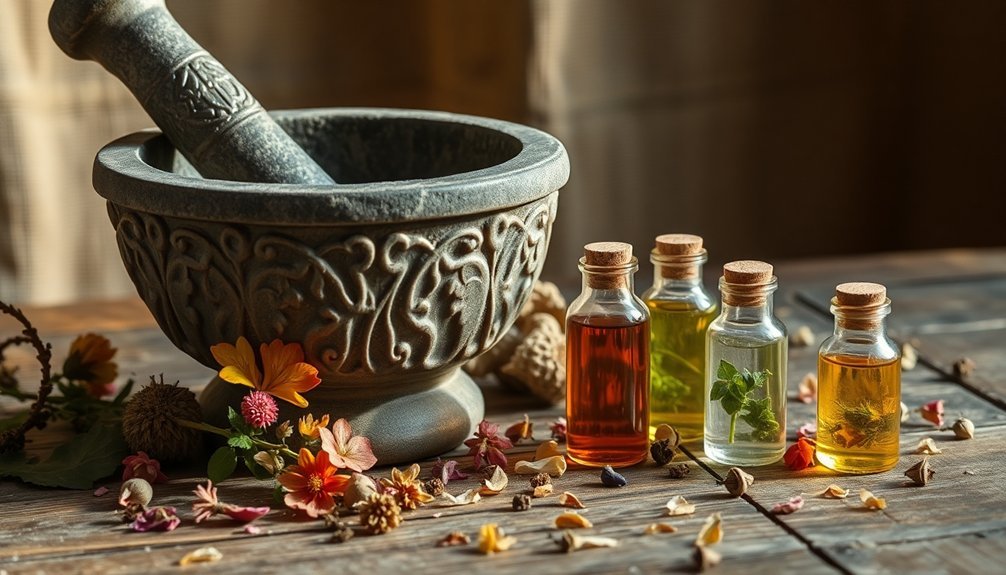
While modern perfumery relies heavily on synthetic materials and advanced technology, ancient civilizations developed remarkably sophisticated methods to extract fragrances from natural sources.
You'll find that early perfumers mastered several extraction techniques, including cold pressing and steam distillation, to capture nature's precious scents.
The ancient Egyptians pioneered methods like enfleurage, where they'd press flowers into animal fats to extract their aromatic compounds.
They'd also use steeping and maceration, soaking plant materials in solvents to release their fragrant oils.
The Romans refined these techniques further, using omphacium – oil from unripe olives or grapes – as a base for their perfumes.
They'd combine this with various plant materials, from flower petals to tree bark, creating complex and lasting fragrances. Some Roman perfumers would extract scents by burying jars in sand and using the heat to separate aromatic compounds.
Early Pressing Techniques Across Civilizations
You'll find fascinating differences in how ancient civilizations pressed their perfumes, from the Mediterranean's precise cold-press methods to Egypt's systematic plant-pressing techniques.
While Greeks and Romans focused on oil-based extraction using mechanical pressure, Asian cultures developed unique pressing methods incorporating sacred woods and rare flowers.
These early pressing techniques laid the groundwork for modern perfumery, with each civilization contributing its own innovations to the art of fragrance extraction. During this time, essential oils obtained through pressing were commonly used in religious ceremonies and for treating various ailments.
Ancient Egyptian Press Methods
Throughout ancient Egypt's rich history, pressing techniques formed the backbone of their sophisticated perfume-making processes.
You'll find that ancient Egyptians relied heavily on cold pressing to extract essential oils from plants, using mortars and pestles to crush and grind the raw materials.
They'd also employ a method called enfleurage, where they'd press flowers and herbs into animal fats, typically lard, to capture their fragrances.
This process required specialized containers and careful oversight by skilled workers, as depicted in their relief carvings. Professional testers were essential for ensuring quality control.
The extracted perfumes weren't just for beauty – they served important roles in religious ceremonies, embalming practices, and as status symbols.
Whether you were a noble or a priest, you'd recognize these pressed perfumes as valuable commodities in trade and daily life.
Mediterranean Cold Press Evolution
The Mediterranean region's cold press methods emerged from a rich tapestry of ancient civilizations, each adding their own innovations to perfume extraction.
You'll find that Greeks pioneered the use of local herbs and flowers, crafting sophisticated blends for both social events and religious ceremonies.
Romans advanced these techniques by developing strategic methods like steeping ingredients in oil and water under hot conditions.
They'd bury earthenware pots filled with oil and rainwater mixtures in sand, letting the water evaporate to capture fragrant oils.
Meanwhile, Arab perfumers revolutionized the process by introducing the alembic and perfecting alcohol distillation for essential oils.
This innovation was so effective that you can still detect traces of their perfumes in ancient locations like Tutankhamen's tomb, proving the durability of their extraction methods.
Traditional Asian Press Practices
Ancient Asian civilizations mastered perfume extraction through distinctive pressing techniques that shaped global fragrance traditions.
You'll find that Indian artisans combined traditional Ayurvedic methods with Islamic practices, creating sophisticated attars through pressed herbs and spices.
Chinese craftsmen developed intricate pressing systems for exotic resins, while Southeast Asian cultures adapted these methods using their abundant local flora.
- Feel the spiritual connection as you discover how ancient perfumers pressed sacred ingredients for temple ceremonies
- Marvel at the ingenuity of combining Middle Eastern and Asian techniques to create unique fragrances
- Experience the legacy of royal perfumers who crafted exclusive scents for emperors and kings
- Imagine the careful precision of pressing delicate flower petals to release their precious essences
- Connect with centuries of tradition as you learn how these methods still influence modern perfumery
Traditional Egyptian Ceramic Vessel Extraction
The ancient Egyptians developed sophisticated methods for extracting perfume oils using specially designed ceramic vessels, which were often found in burial chambers alongside mummies and sacred artifacts.
You'll find that these vessels featured narrow necks and distinct shapes that helped control the heating process while minimizing evaporation during oil extraction from resins, flowers, and herbs.
The clay vessels were particularly effective at collecting and concentrating fragrant compounds, as their porous nature allowed for gradual cooling and ideal separation of the aromatic oils.
Ancient Burial Oil Process
Deep within Egyptian burial chambers, skilled perfumers crafted sacred oils using specialized ceramic vessels designed for extracting fragrant essences.
You'll find that these ancient artisans combined plant-based oils like myrrh and frankincense with animal-derived ingredients through a sacred heating process. They'd grind ingredients with mortars and pestles before transferring them to blessed clay vessels for extraction.
- The sweet aroma of jasmine and lavender filled the air as perfumers chanted prayers for divine guidance.
- Sacred incense smoke swirled around alabaster containers, carrying wishes to the gods.
- Each ingredient received a ritual blessing to guarantee its purity and power.
- Perfumers worked in reverent silence, knowing their creations would guide souls to the afterlife.
- The final oils were sealed in precious vessels, ready to accompany the deceased on their eternal journey.
Clay Vessel Fragrance Collection
Building upon these sacred practices, skilled Egyptian perfumers mastered fragrance collection through specialized clay vessel techniques. They'd carefully select narrow-necked clay containers to prevent precious aromas from escaping during the extraction process.
You'll find that these artisans employed various methods with their vessels. They'd heat them to draw out essential oils from resins like frankincense and myrrh, while using mortars and pestles to grind spices such as cinnamon and nutmeg.
For delicate flowers, they'd use the enfleurage technique, pressing the petals into animal fats within the vessels to capture their essence. Steam distillation was another key method – they'd boil plants in water-filled vessels and condense the aromatic steam.
After extraction, they'd transfer the finished perfumes to decorated pottery flasks for storage and distribution.
Historical Uses of Heat and Evaporation
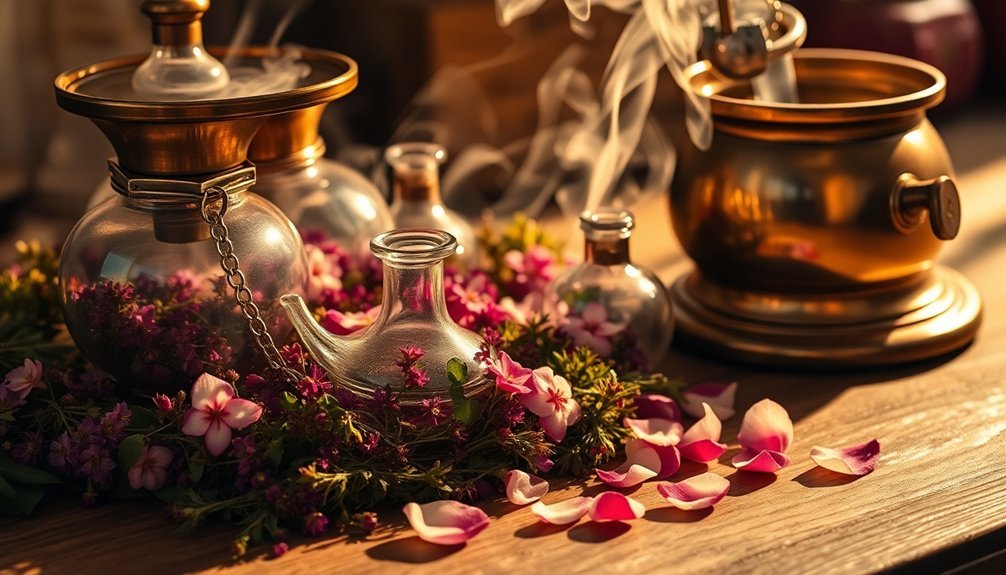
Throughout history, perfume makers relied heavily on heat and evaporation to reveal nature's most enchanting scents.
You'll find ancient Mesopotamians burning resins, while Arab alchemists perfected distillation during the Middle Ages. They'd heat plant materials with steam, allowing oils to evaporate and condense into pure fragrances.
Hot enfleurage emerged as a fascinating technique where flowers were stirred into warm fats, creating aromatic pomades that were later refined with alcohol.
- Feel the warmth of ancient fires releasing sacred incense into the air
- Imagine delicate flower petals dancing in heated oils
- Picture steam rising from copper stills, carrying precious aromatic molecules
- Envision skilled artisans carefully stirring blossoms in warm, fragrant fats
- Experience the magic of seeing clear oils emerge from condensed vapors
Ancient Filtration Systems and Methods
When ancient perfumers sought simpler extraction methods, they turned to filtration as a practical alternative to heat-based techniques. You'll find that they used basic tools like cloth and filter paper to separate aromatic compounds from crushed plant materials.
This method often involved mixing the filtered extracts with carrier oils like olive, sesame, or almond oil to create perfumed products. While not as efficient as distillation for extracting strong fragrances, filtration made perfume production more accessible since it didn't require complex equipment.
You'll notice that ancient civilizations from Mesopotamia to Egypt refined this technique by combining it with manual pressing and other methods.
They'd maintain their filtration equipment regularly, using cauldrons and containers to mix materials before filtering them through progressively finer materials to achieve the desired results.
The Discovery of Basic Distillation

Ancient civilizations made remarkable strides in perfume extraction once they discovered the power of distillation.
You'll find that the Egyptians pioneered this technique using basic clay stills to draw out aromatic oils, while the Greeks refined the process with their innovative bent-pipe system.
By the Middle Ages, you'd see the introduction of copper alembic stills, which revolutionized the industry with precise temperature control.
- Feel the mystical allure of ancient Egyptian perfumers extracting precious oils drop by drop
- Imagine the excitement of Greek inventors as they first witnessed aromatic vapors condensing into liquid gold
- Experience the therapeutic power of Persian rosewater, crafted with centuries-old wisdom
- Marvel at the dedication required to process thousands of delicate flowers for a single ounce of essence
- Picture yourself in a medieval laboratory, where copper stills transformed botanical treasures into liquid art
Natural Solvent Methods in Early Times
Before the advent of modern technology, perfumers relied on ingenious natural solvent methods to capture the essence of fragrant materials. You'll find that traditional solvent extraction used chemicals like hexane to dissolve aromatics, while the French enfleurage method employed fats to absorb delicate flower essences. Both techniques required patience and precision to preserve the integrity of natural fragrances.
| Method | Process | Best For |
|---|---|---|
| Traditional Solvent | Submerge in hexane/ether | Woody materials |
| Enfleurage | Press into fat, wash with alcohol | Delicate flowers |
| Multiple-Step | Solvent soak, then alcohol wash | Large quantities |
| Early Distillation | Heat and steam | Hardy plants |
| Cold Press | Mechanical pressure | Citrus peels |
Though these methods were labor-intensive, they laid the foundation for modern perfume extraction techniques. You'll appreciate how these early innovators developed processes that still influence today's perfume industry.
Primitive Sublimation Techniques
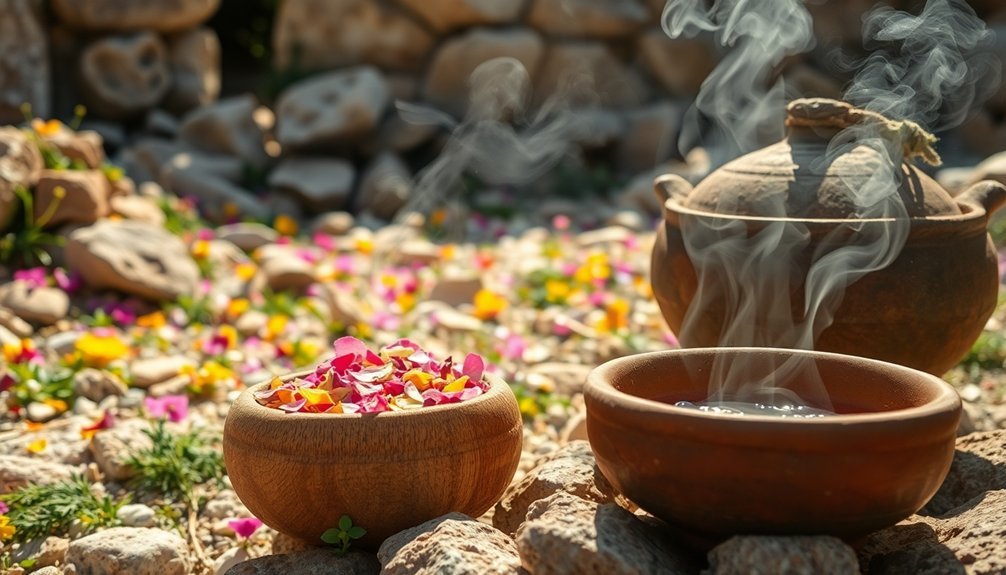
Through the remarkable ingenuity of early perfumers, sublimation techniques emerged as one of the first methods to capture fragrant compounds.
You'll find that early artisans used slow heating processes with bain-maries and cleverly positioned mirrors to harness the sun's heat. They'd heat plant materials carefully, allowing the steam to rise through serpentine pipes before condensing into precious oils and floral waters.
- Feel the ancient wisdom of Arab alchemists as they perfect their craft with meticulously designed alembics
- Experience the patient process of capturing delicate essences through multi-stage distillation
- Imagine the satisfaction of watching crystal-clear droplets form in coiled condensation pipes
- Marvel at the artistry of creating transparent absolutes from deep-colored rose oils
- Connect with centuries of tradition as you discover how modern techniques evolved from these humble beginnings
Sacred Plant Extraction Rituals
Sacred plant extraction has long intertwined spiritual reverence with practical methodology. When you're extracting sacred plants like frankincense, sandalwood, or palo santo, you'll find that traditional methods carry deep cultural significance.
You'll discover that each extraction method serves a specific purpose. Steam distillation works best for sandalwood's precious oils, while frankincense requires resin extraction from tree bark. For champaca flowers, you'll need gentle solvent extraction to preserve their delicate properties. Cold pressing works effectively for citrus-based sacred oils.
These extraction methods don't just serve practical purposes – they're often accompanied by specific rituals. Whether you're harvesting palo santo wood or collecting frankincense resin, many cultures maintain ceremonial practices during extraction to honor the plants' sacred nature and preserve their spiritual properties.
Frequently Asked Questions
How Did Ancient Perfumers Test the Quality of Their Extracted Scents?
You'd find ancient perfumers testing scent quality through subjective evaluation, checking ingredient purity, and examining how well components blended. They'd also rely on traditional recipes and descriptions from historical texts to assess quality.
What Tools Were Used to Measure Precise Quantities in Early Perfume Extraction?
You'll find that early perfumers didn't have many specialized measuring tools. They relied mainly on their experience, using basic weight scales, volume containers, and their senses to determine proper quantities for extraction.
How Long Could Ancient Perfume Extracts Maintain Their Scent?
You'll find that ancient perfume extracts could last for centuries, especially Egyptian ones. When properly stored, their rich oils, resins, and natural ingredients maintained strong fragrances, as proven by archaeological discoveries.
Which Extraction Methods Were Considered Dangerous in Ancient Times?
You'll find that sublimation and open-flame distillation were the most dangerous methods. They posed risks of burns, fires, and explosions. Working with animal-based ingredients like musk also carried health hazards from diseases.
Did Weather Conditions Affect the Success of Traditional Perfume Extraction Methods?
Yes, you'll find weather greatly impacted traditional perfume extraction. High temperatures damaged oils during steam distillation, rain made flowers fragile for enfleurage, and humidity interfered with solvent evaporation in solvent extraction.
In Summary
You've now learned how our ancestors ingeniously extracted fragrances through pressing, heating, and distillation. These time-tested methods, from Egypt's ceramic vessels to early solvent techniques, laid the foundation for modern perfumery. While today's methods are more sophisticated, you can still appreciate how these ancient extraction processes shaped our understanding of capturing nature's most delicate scents. It's fascinating to see how far we've come from these original techniques.

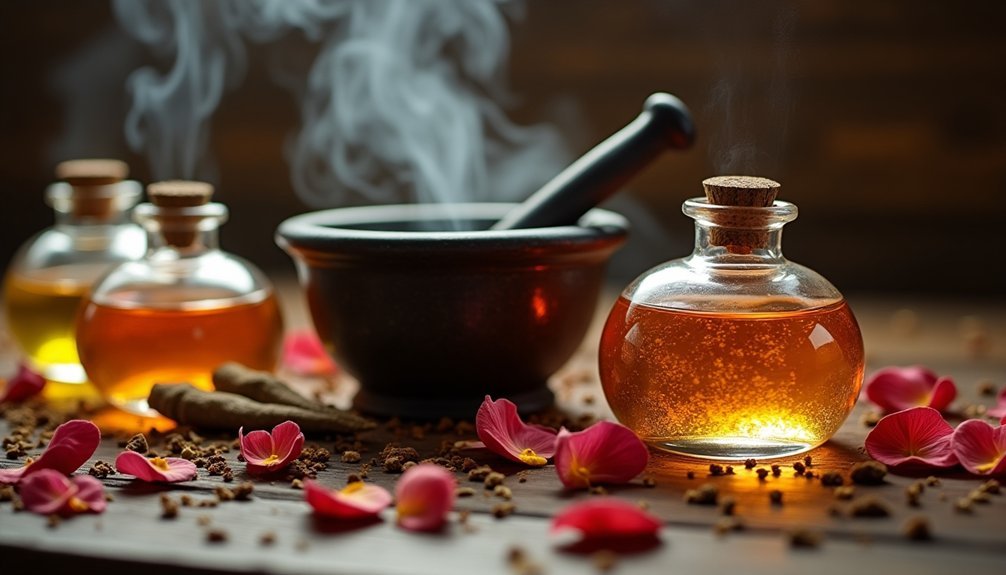
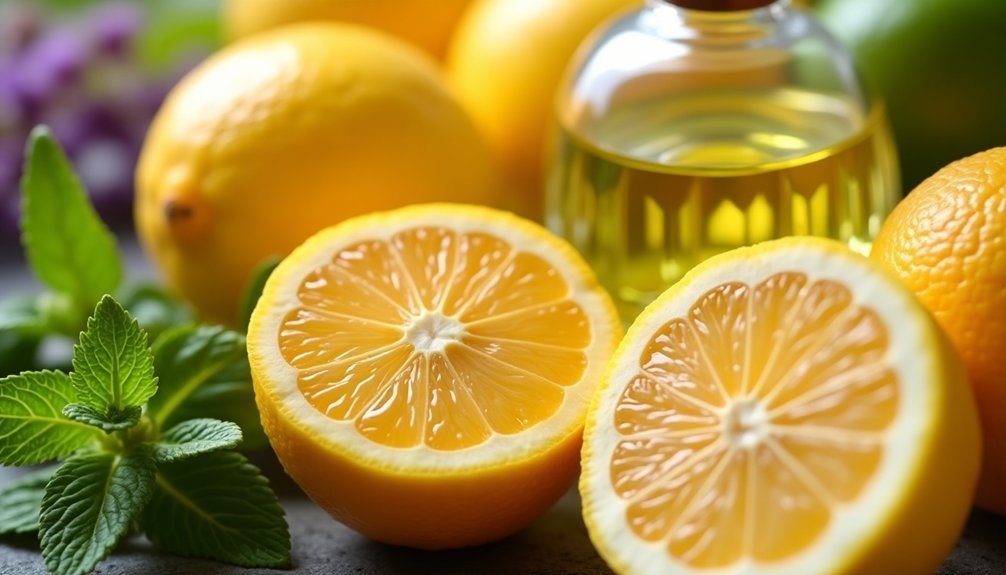
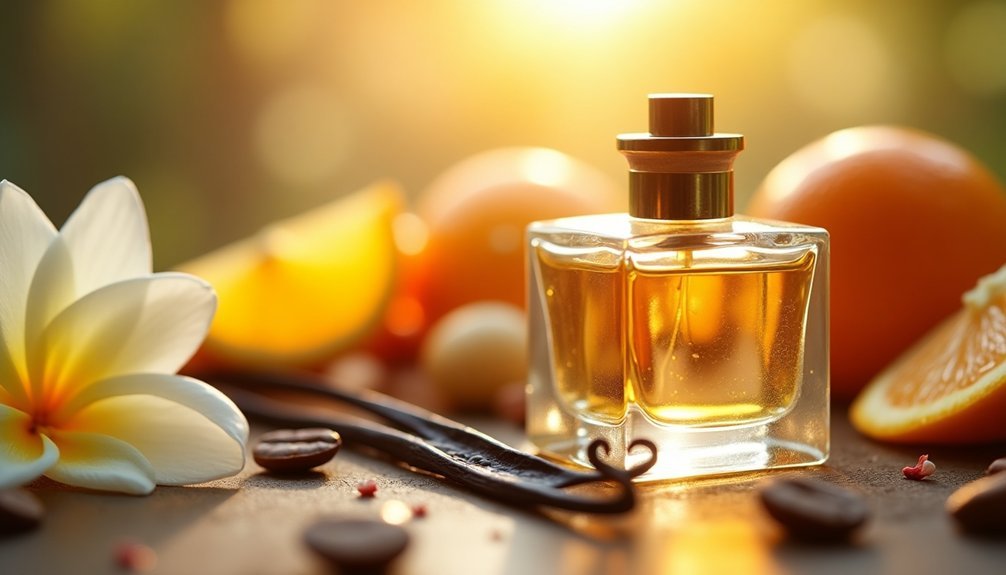

Leave a Reply